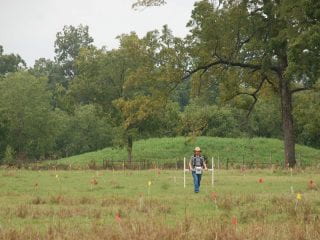Remains at Crenshaw Site Are Local, Ancestors of Caddo, Study Finds

Samuelsen conducting gradiometry survey at the Crenshaw site in southwest Arkansas.
FAYETTEVILLE, Ark. – Hundreds of human skulls and mandibles recovered from the Crenshaw site in southwest Arkansas are the remains of ancestors of the Caddo Nation and not foreign enemies, according to a new study published in the Journal of Archaeological Science.
Collaborating with the Caddo Nation in Oklahoma, researchers at the University of Arkansas and Arkansas Archeological Survey tested lead and strontium isotopes in the teeth of human remains and compared them to ancient animal teeth from several surrounding regions to determine that the 700-year-old human remains were local people.
“Our study tested and ultimately refutes hypotheses that the Crenshaw remains are ‘trophy skulls’ killed during raiding expeditions,” said lead author John Samuelsen. “Demonstrating that the remains are Caddo ancestors provides both researchers and the Caddo Nation a clear answer to questions that have long persisted about the site and the remains.”
Samuelsen serves as science and technology administrator at the Arkansas Archeological Survey and a graduate faculty member in the Department of Anthropology at the U of A. He specializes in geochemical analysis of remains and archeological materials to detect geographical movement of ancient people and animals.
For the Crenshaw study, he worked with Adriana Potra, associate professor in the Department of Geosciences at the U of A. Potra, who studies ore geology and radiogenic isotope geochemistry to enhance an understanding of the geochemistry and tectonic framework of ore deposits, helped improve scientific methods using the lead isotopes.
Their study of the Crenshaw site is the first to use lead isotopes in ancient animal teeth from many different regions to evaluate where humans lived. These isotopes in tooth enamel are set during childhood tooth formation and reflect the isotopes in the underlying geology where the children grew up.
About the Arkansas Archeological Survey: The Arkansas Archeological Survey was established by statute in 1967 to study Arkansas’ past, to preserve and manage information about archeological sites, and to share this knowledge with the public. The Survey maintains 10 research stations staffed by Ph.D.-level archeologists distributed across Arkansas, as well as a coordinating office in Fayetteville also managing more than 7 million artifacts in the ARAS holdings. The Arkansas Archeological Survey is part of the University of Arkansas System.
About the University of Arkansas: As Arkansas’ flagship institution, the U of A provides an internationally competitive education in more than 200 academic programs. Founded in 1871, the U of A contributes more than $2.2 billion to Arkansas’ economy through the teaching of new knowledge and skills, entrepreneurship and job development, discovery through research and creative activity while also providing training for professional disciplines. The Carnegie Foundation classifies the U of A among the few U.S. colleges and universities with the highest level of research activity. U.S. News & World Report ranks the U of A among the top public universities in the nation. See how the U of A works to build a better world at Arkansas Research and Economic Development News.
This story also appeared in the University of Arkansas News publication.

